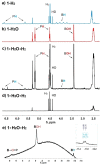Water Reduction and Dihydrogen Addition in Aqueous Conditions With ansa-Phosphinoborane
- PMID: 35861909
- PMCID: PMC9804508
- DOI: 10.1002/chem.202201927
Water Reduction and Dihydrogen Addition in Aqueous Conditions With ansa-Phosphinoborane
Abstract
Ortho-phenylene-bridged phosphinoborane (2,6-Cl2 Ph)2 B-C6 H4 -PCy2 1 was synthesized in three steps from commercially available starting materials. 1 reacts with H2 or H2 O under mild conditions to form corresponding zwitterionic phosphonium borates 1-H2 or 1-H2 O. NMR studies revealed both reactions to be remarkably reversible. Thus, when exposed to H2 , 1-H2 O partially converts to 1-H2 even in the presence of multiple equivalents of water in the solution. The addition of parahydrogen to 1 leads to nuclear spin hyperpolarization both in dry and hydrous solvents, confirming the dissociation of 1-H2 O to free 1. These observations were supported by computational studies indicating that the formation of 1-H2 and 1-H2 O from 1 are thermodynamically favored. Unexpectedly, 1-H2 O can release molecular hydrogen to form phosphine oxide 1-O. Kinetic, mechanistic, and computational (DFT) studies were used to elucidate the unique "umpolung" water reduction mechanism.
Keywords: DFT; frustrated Lewis pairs; hydrogen activation; mechanism; umpolung of proton; water reduction.
© 2022 The Authors. Chemistry - A European Journal published by Wiley-VCH GmbH.
Conflict of interest statement
The authors declare no conflict of interest.
Figures












Similar articles
-
Reduction of Phosphine Oxide by Using Chlorination Reagents and Dihydrogen: DFT Mechanistic Insights.Chemistry. 2019 Mar 27;25(18):4670-4672. doi: 10.1002/chem.201900379. Epub 2019 Mar 12. Chemistry. 2019. PMID: 30758069
-
Proton to hydride umpolung at a phosphonium center via electron relay: a new strategy for main-group based water reduction.Chem Sci. 2021 Nov 15;12(47):15603-15608. doi: 10.1039/d1sc05135k. eCollection 2021 Dec 8. Chem Sci. 2021. PMID: 35003590 Free PMC article.
-
Nuclear spin hyperpolarization with ansa-aminoboranes: a metal-free perspective for parahydrogen-induced polarization.Phys Chem Chem Phys. 2016 Oct 12;18(40):27784-27795. doi: 10.1039/c6cp05211h. Phys Chem Chem Phys. 2016. PMID: 27711602
-
Spontaneous 15N Nuclear Spin Hyperpolarization in Metal-Free Activation of Parahydrogen by Molecular Tweezers.J Phys Chem Lett. 2018 Feb 15;9(4):903-907. doi: 10.1021/acs.jpclett.7b03433. Epub 2018 Feb 8. J Phys Chem Lett. 2018. PMID: 29401399 Free PMC article.
-
Intramolecular frustrated Lewis pair with the smallest boryl site: reversible H2 addition and kinetic analysis.Angew Chem Int Ed Engl. 2015 Feb 2;54(6):1749-53. doi: 10.1002/anie.201410141. Epub 2014 Dec 17. Angew Chem Int Ed Engl. 2015. PMID: 25521538
Cited by
-
Unconventional Parahydrogen-Induced Hyperpolarization Effects in Chemistry and Catalysis: From Photoreactions to Enzymes.ACS Catal. 2025 Apr 4;15(8):6386-6409. doi: 10.1021/acscatal.4c07870. eCollection 2025 Apr 18. ACS Catal. 2025. PMID: 40270879 Free PMC article. Review.
References
Grants and funding
LinkOut - more resources
Full Text Sources

